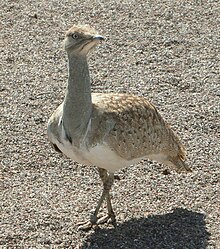
Back حبارى إفريقي Arabic حبارى افريقى ARZ Gözəl baladovdaq Azerbaijani Африканска хубара Bulgarian Otiz houbara Breton Hubara africana Catalan Chlamydotis undulata CEB Ceiliog gwaun copog Welsh Kravetrappe Danish Saharakragentrappe German
| African houbara | |
|---|---|

| |
| Scientific classification | |
| Domain: | Eukaryota |
| Kingdom: | Animalia |
| Phylum: | Chordata |
| Class: | Aves |
| Order: | Otidiformes |
| Family: | Otididae |
| Genus: | Chlamydotis |
| Species: | C. undulata
|
| Binomial name | |
| Chlamydotis undulata (Jacquin, 1784)
| |

| |
| Range of Ch. undulata Extant (resident) Possibly extant (resident) Possibly extinct
| |
The African houbara (Chlamydotis undulata), also known as the houbara bustard (houbara from Arabic: حُبَارَى, romanized: ḥubārā for bustards in general), is a relatively small bustard native to North Africa, where it lives in arid habitats. The global population is listed as Vulnerable on the IUCN Red List since 2014.[1] There is a population in the Canary Islands which was assessed as Near Threatened in 2015, but has since also been assessed as Vulnerable.[2]
It is dull brown with black markings on the wings, a greyish neck and a black ruff along the side of the neck. Males are larger and heavier than females.
- ^ a b c BirdLife International. (2023). "Chlamydotis undulata". IUCN Red List of Threatened Species. 2023: e.T22728245A208501099. doi:10.2305/IUCN.UK.2023-1.RLTS.T22728245A208501099.en.
- ^ BirdLife International. (2021). "Chlamydotis undulata (Europe assessment)". IUCN Red List of Threatened Species. 2021: e.T22728245A166436759. doi:10.2305/IUCN.UK.2021-3.RLTS.T22728245A166436759.en.
